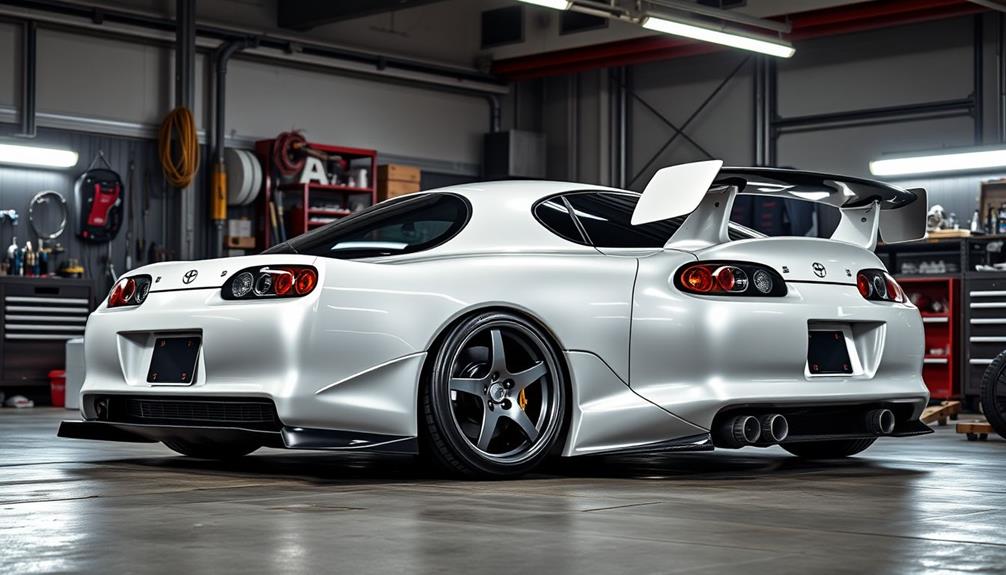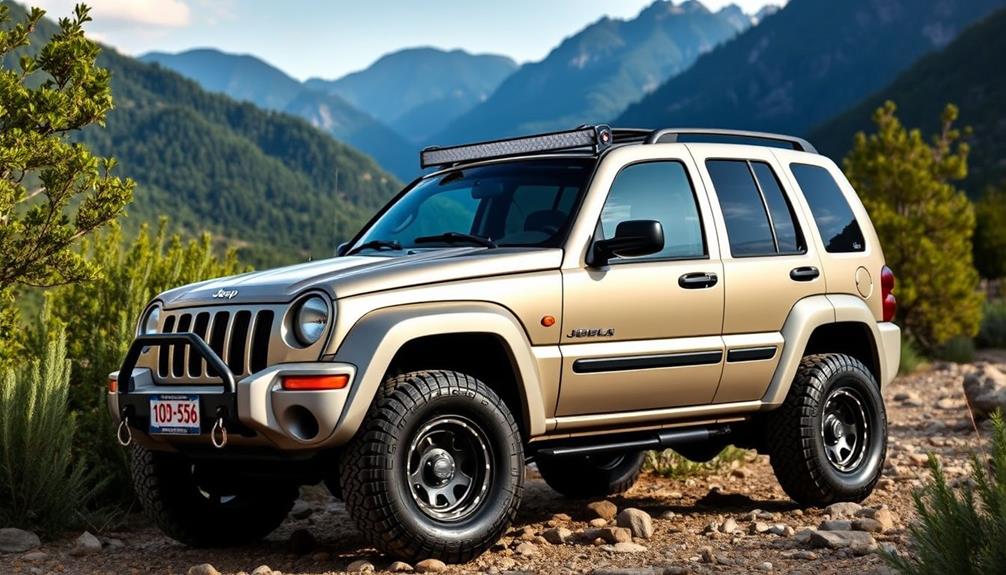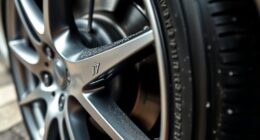Tuning your 1998 Toyota Supra can turn your classic ride into a supercar powerhouse. Start with performance enhancements like high-flow intake and exhaust systems to boost airflow and reduce back pressure. Upgrade your intercooler and ECU for better combustion and optimized engine management. Stiffer suspension and weight reduction strategies improve handling and responsiveness. Don't overlook brake upgrades for superior stopping power and lightweight wheels to enhance grip. Aesthetic touches, like carbon fiber parts, add style while trimming weight. Each modification releases more potential, making your Supra an exhilarating driving experience, and there's much more to explore on this journey!
Key Takeaways
- Upgrade the intake and exhaust systems to improve airflow and increase engine power output significantly.
- Enhance boost pressure with upgraded controllers and intercoolers for better combustion and throttle response.
- ECU tuning optimizes fuel mixtures, ensuring safe and efficient performance after modifications.
- Implement suspension upgrades like stiffer springs and adjustable coilovers to enhance handling and cornering stability.
- Upgrade brakes and tires with performance components to improve stopping power and overall grip during spirited driving.
Intake and Exhaust System Upgrades
When it comes to boosting your 1998 Toyota Supra's performance, upgrading the intake and exhaust systems is a must. A high-performance intake system can cost anywhere from $500 to $2000, and it greatly enhances airflow to your engine. This improvement results in better throttle response and increased power output, allowing your 2JZ-GTE engine to reach its full potential.
The factory intake often restricts airflow due to smaller pipes, so investing in an aftermarket option is vital.
On the flip side, an aftermarket exhaust system, priced between $1000 and $5000, reduces back pressure and improves engine breathing. This upgrade not only delivers increased horsepower but also creates a more aggressive exhaust note that's sure to turn heads.
A free-flowing exhaust system lowers exhaust temperatures, making your engine more efficient and effective.
Both the intake and exhaust system upgrades are essential for releasing the full potential of your Supra's engine. By enhancing airflow and efficiency, you'll experience a noticeable performance boost that takes your driving experience to the next level.
Don't overlook these modifications; they're imperative for any performance enthusiast looking to elevate their ride.
Boost Pressure and Intercooler Enhancements
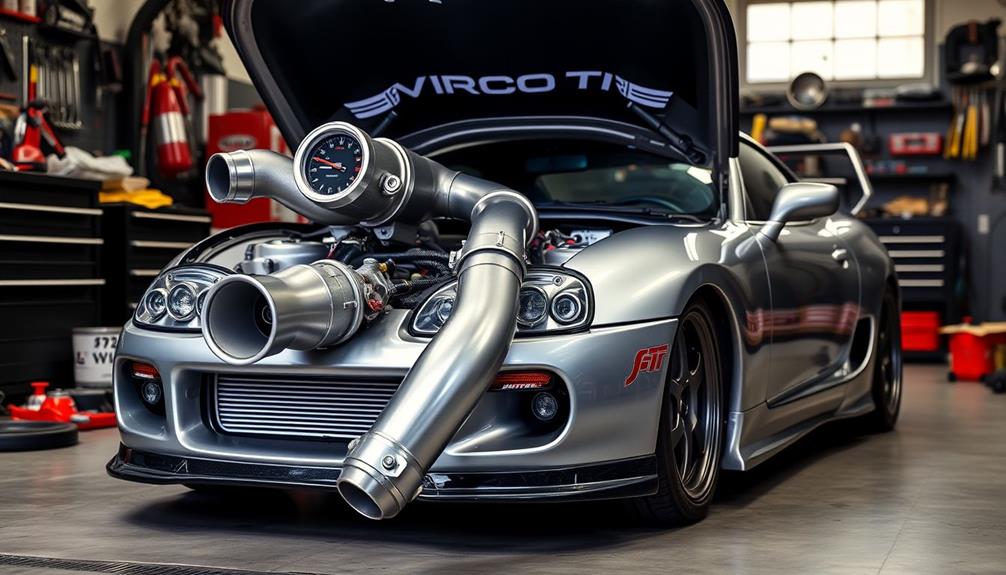
Boosting your 1998 Toyota Supra's turbo pressure can open up impressive performance gains, but it's crucial to optimize your intercooler for maximum efficiency.
By upgrading to a high-performance intercooler, you'll keep the intake air cooler, improving combustion and overall power.
Let's explore how adjusting boost levels and enhancing intercooler performance can elevate your driving experience.
Increasing Turbo Boost Efficiency
Turbocharging your 1998 Toyota Supra can release impressive horsepower gains through increased boost pressure and upgraded intercooler systems.
By focusing on these enhancements, you can considerably improve your car's performance. Here's how to maximize turbo boost efficiency:
- Increase Boost Pressure: Upgrading your boost controller can allow more compressed air into the engine, leading to significant horsepower gains. Expect to invest between $200 and $600 for this vital adjustment.
- Install an Upgraded Intercooler: A high-performance intercooler helps cool the compressed air, increasing oxygen density for better combustion and overall efficiency. Costs for this upgrade typically range from $500 to $1500.
- Tune Your ECU: After installing the upgraded intercooler and increasing boost pressure, tuning your ECU guarantees the engine can effectively utilize the additional air intake. This step is fundamental for maximizing performance without compromising reliability.
Together, these modifications can lead to a considerable increase in torque and throttle response, enhancing your driving experience.
Intercooler Performance Optimization
Maximizing the performance of your 1998 Toyota Supra involves not just increasing boost pressure but also optimizing the intercooler's efficiency.
When you boost the pressure, you can achieve significant horsepower gains, but to truly harness that power, you need an effective intercooler. Upgrading from the factory intercooler to a high-performance aftermarket model can greatly enhance intercooler performance optimization, allowing for better airflow and cooler compressed air.
Cooler air means increased oxygen density, which leads to better combustion and improved power output during high-performance driving. This is vital for your 2JZ-GTE engine to reach its full potential.
Costs for intercooler upgrades typically range from $500 to $1500, but the investment pays off in performance.
Don't overlook the installation—properly installing your intercooler guarantees you fully benefit from the enhanced cooling. Without it, you risk losing the performance gains you've worked hard to achieve.
Combining higher boost pressure with a more efficient intercooler is fundamental for making your Supra a true supercar contender.
ECU and Cooling System Modifications

When tuning your 1998 Toyota Supra, focusing on ECU and cooling system modifications is vital for revealing the engine's full potential.
ECU tuning fine-tunes fuel and oxygen mixtures, leading to significant power increases. After major upgrades like increased boost pressure, a proper ECU tune is necessary to guarantee your engine runs efficiently and safely. This investment typically costs between $500 and $1000.
Additionally, upgrading your cooling system is fundamental. A robust cooling system prevents overheating during high-performance driving, particularly with more powerful setups.
Here are three key upgrades to take into account:
- Larger Aluminum Radiators: These improve coolant capacity and help maintain ideal temperatures.
- Efficient Cooling Fans: These enhance airflow, ensuring your engine stays cool under demanding conditions.
- High-Quality Coolant: Using a specialized coolant can further enhance thermal efficiency.
Suspension Enhancements for Performance
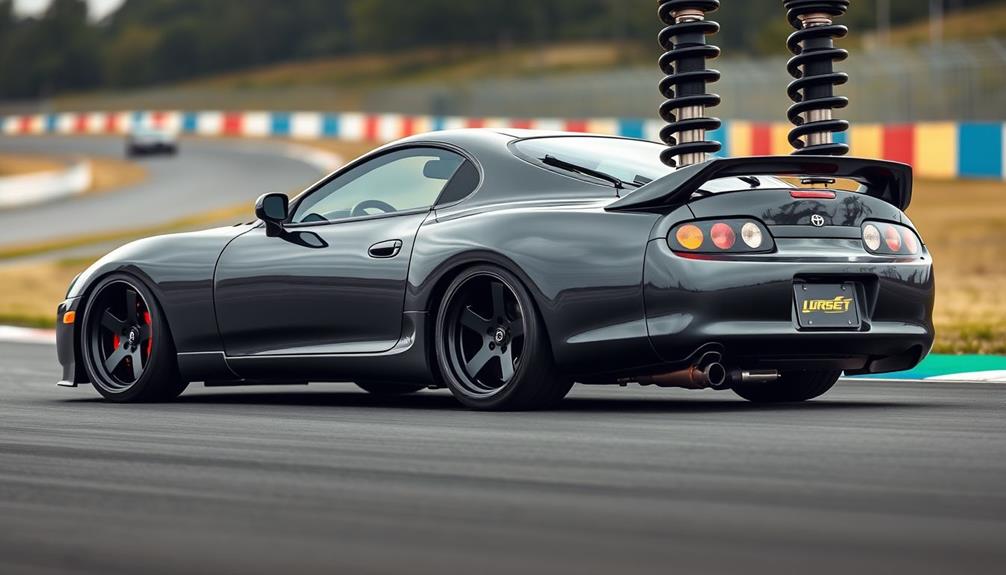
Upgrading to stiffer springs in your 1998 Toyota Supra can drastically improve handling and reduce body roll during sharp turns.
You'll notice better weight distribution, which enhances cornering stability and responsiveness.
With the right suspension enhancements, you'll transform your driving experience into something truly exhilarating.
Stiffer Springs Benefits
Stiffer springs bring significant benefits to the 1998 Toyota Supra's performance, particularly in handling and stability. By reducing body roll during cornering, you'll notice the car becomes much more responsive to your inputs, allowing for a thrilling driving experience.
Additionally, understanding the impact of budgeting for upgrades is essential to guarantee you can afford these enhancements without compromising your financial health.
Here are three key advantages of upgrading to stiffer springs:
- Improved Weight Transfer: Stiffer springs enhance weight distribution during acceleration and braking, translating to better traction and stability on the road.
- Enhanced Ride Quality: While you might think that stiffer equals harsher, these springs can actually improve ride quality on smooth surfaces, making your daily drives more enjoyable.
- Greater Grip in Turns: When paired with thicker sway bars, stiffer springs provide additional control, helping the Supra maintain grip through sharp turns.
With the right setup, stiffer springs and upgraded dampers work together to meet the increased performance demands from engine modifications and aggressive driving styles.
This combination guarantees your Supra not only looks great but also performs like a true supercar on both the street and the track.
Enhanced Handling Characteristics
Enhancing the handling characteristics of your 1998 Toyota Supra goes hand in hand with suspension upgrades. By upgrading to stiffer springs and dampers, you'll reduce body roll during cornering, providing a more stable ride at high speeds.
Additionally, consider the benefits of lighter components, such as unique and wicked planters, which can translate to similar principles of weight reduction in automotive performance. Thicker sway bars will further enhance your vehicle's stability and control, allowing for sharper turns and better responsiveness when maneuvering tight corners.
Don't overlook the benefits of installing polyurethane bushings. These will increase your suspension's responsiveness and durability, translating to improved feedback during aggressive driving.
A thorough suspension setup, including adjustable coilovers, lets you fine-tune your ride height and damping settings to match your personal driving style.
Incorporating light-weight wheels is another vital performance upgrade. These help reduce unsprung weight, enhancing your Supra's agility and improving overall handling.
Every modification works together to create a more dynamic driving experience, allowing you to tackle corners with confidence.
With these enhancements, your Supra won't just perform better; it'll feel like a true supercar on the road. Embrace these upgrades, and you'll appreciate the transformation in your driving experience.
Weight Distribution Improvements
Achieving ideal weight distribution is fundamental for maximizing the performance of your 1998 Toyota Supra, especially during spirited driving.
By refining your suspension setup, you can dramatically enhance handling and stability. Here are three key upgrades to take into account:
- Stiffer Springs and Dampers: Upgrading these components reduces body roll, enhancing cornering stability and overall handling.
- Thicker Sway Bars: These improve vehicle rigidity during turns, promoting better weight distribution and control in high-speed corners.
- Coilover Suspension Systems: Adjusting ride height can enhance the center of gravity, resulting in balanced weight distribution and improved traction.
Additionally, think about replacing factory rubber bushings with polyurethane ones.
These provide more responsive steering and feedback, vital for maintaining ideal weight distribution in dynamic driving.
Upgrading the Brake System
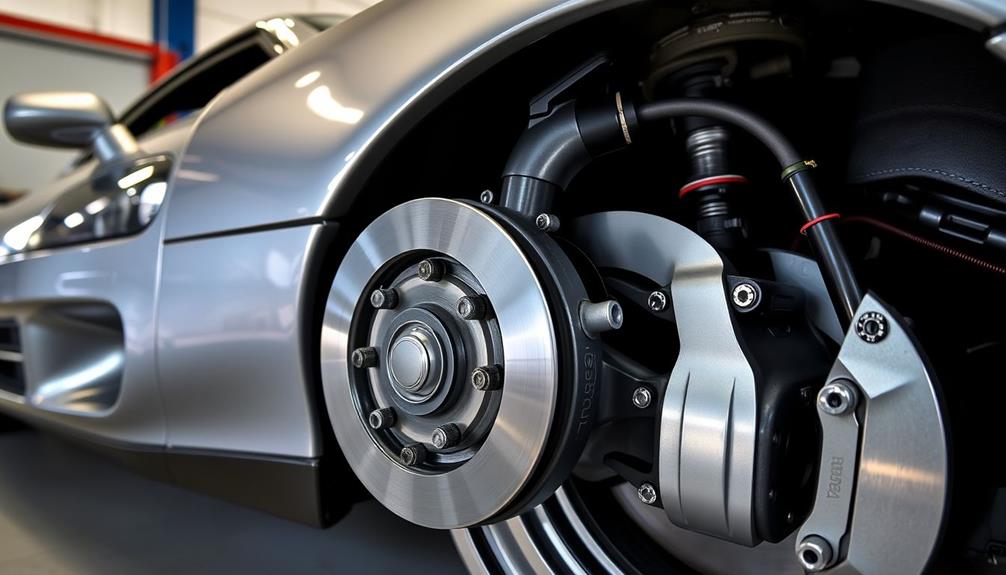
When you decide to upgrade the brake system on your 1998 Toyota Supra, you're taking an important step toward improving both safety and performance.
Start by installing performance brake pads, specifically designed to handle high temperatures, which will enhance your stopping power and fade resistance. This is vital, especially if you plan to push your Supra to its limits.
Next, consider upgrading your rotors. High-performance rotors improve heat dissipation, increasing braking efficiency and reducing the risk of brake fade during aggressive driving sessions.
To further enhance your setup, utilize stainless steel brake lines. They provide a more direct connection between you and the braking system, improving pedal feel and responsiveness.
Don't overlook the benefits of larger calipers. They accommodate the increased demands of your upgraded brake system, allowing for better clamping force and greatly improved braking performance.
With these thorough upgrades, you guarantee a balanced enhancement in both safety and performance, which is necessary for handling any added power from engine modifications.
Tire and Wheel Modifications
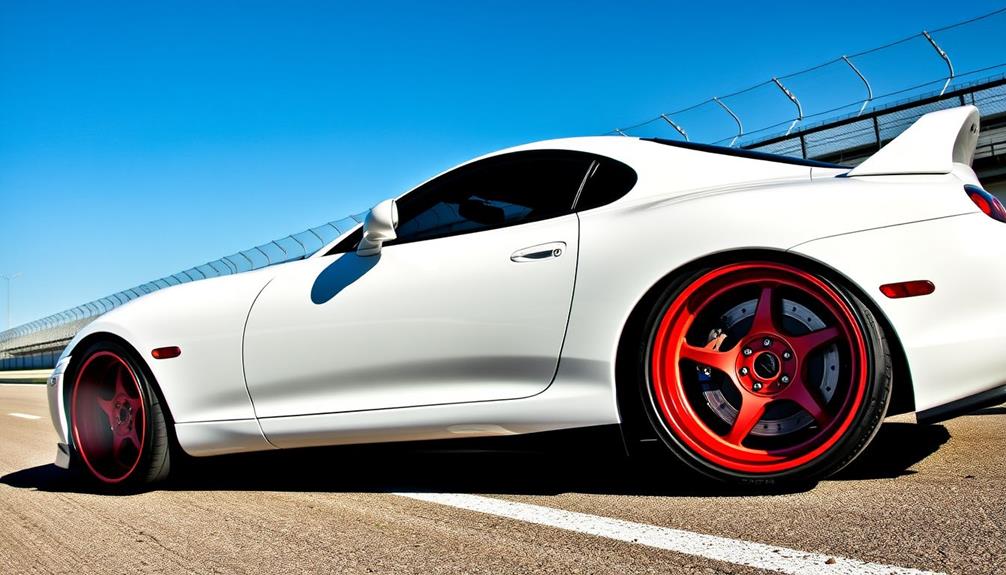
After upgrading your brake system, it's time to focus on tire and wheel modifications to further enhance your 1998 Toyota Supra's performance. The right tires and wheels can greatly improve your driving experience, especially when it comes to grip and handling.
- Wider Tires: Upgrading to wider tires will notably improve grip and handling characteristics, allowing for better acceleration and cornering performance.
- Lightweight Wheels: Consider lightweight options like Valk racing wheels. These wheels reduce unsprung weight, which enhances overall performance and responsiveness, making your Supra feel more agile on the road.
- Race Tire Compound: Selecting a race tire compound is essential, especially for track days. This choice maximizes traction, ensuring peak performance during competitive racing scenarios.
Don't overlook the importance of proper tire pressure too. Setting your front tires to 2 bar and your rear tires to 1.9 bar will help you achieve the ideal balance between grip and tire wear, keeping your performance consistent.
Weight Reduction Strategies

Weight reduction is a game changer for your 1998 Toyota Supra's performance, giving you a noticeable edge in acceleration and handling. By implementing effective weight reduction strategies, you can greatly improve the power-to-weight ratio, potentially saving anywhere from 300 to 1500 pounds.
Start with removing unnecessary components like rear seats and sound deadening materials; this alone can enhance the vehicle's agility and responsiveness during performance driving.
Consider replacing heavy stock parts with lightweight materials such as aluminum or carbon fiber panels. This not only cuts down on weight but also maintains structural integrity, ensuring your Supra remains safe and solid.
Focus on strategic areas like the dashboard, interior components, and even the battery to maximize weight savings without sacrificing too much comfort, perfect for track-focused modifications.
While weight reduction boosts maximum performance, it's crucial to balance these upgrades with the potential for increased wear and tear on drivetrain components. A lighter vehicle can lead to more stress on parts, so approach modifications thoughtfully.
Embrace these weight reduction strategies to release your Supra's true potential on the road or track!
Carbon Fiber and Aesthetic Modifications
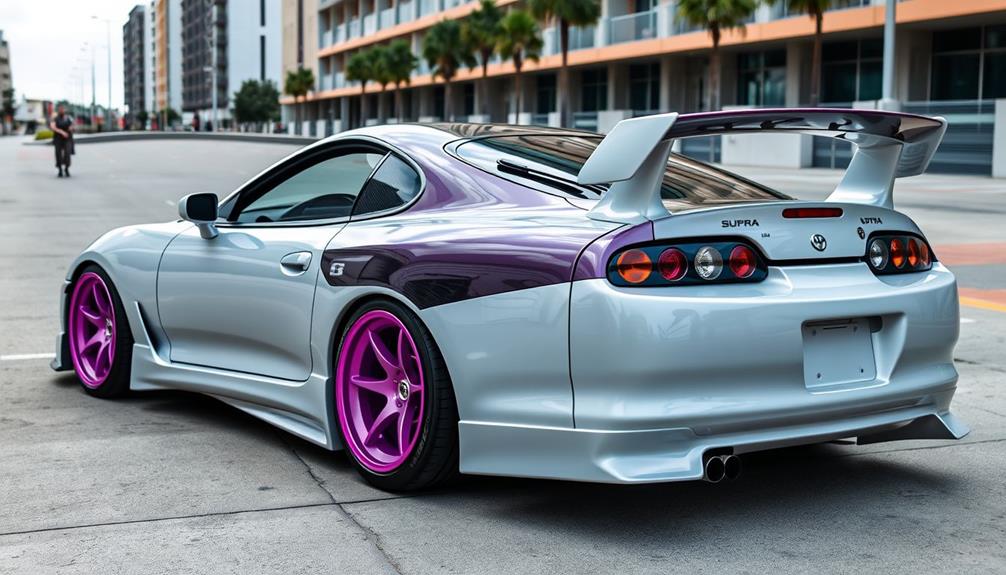
Incorporating carbon fiber into your 1998 Toyota Supra not only enhances its performance but also elevates its aesthetic appeal. By replacing factory parts with carbon fiber panels, you achieve significant weight reduction without compromising style. This lightweight material is perfect for creating a racing-inspired look while improving your car's capabilities.
Here are three key benefits of using carbon fiber modifications:
- Weight Reduction: Lightweight carbon fiber bumpers and seats contribute to better acceleration and handling, making your Supra more responsive on the road or track.
- Enhanced Aesthetic: Carbon fiber adds a sleek, modern touch to your vehicle, elevating its visual impact and showcasing your passion for performance.
- Versatile Options: You can customize various components, from hoods to interior trim, allowing you to tailor the look and feel of your Supra to your liking.
While the cost of carbon fiber modifications can range from hundreds to thousands of dollars, the performance and aesthetic improvements make it a worthy investment.
Balancing these elements guarantees your Supra remains both visually appealing and a serious performance machine.
Track Day Preparation and Resources

Preparing your 1998 Toyota Supra for a track day involves several critical steps to guarantee peak performance and safety. Start with weight reduction strategies by removing unnecessary interior components; this optimizes your power-to-weight ratio, enhancing your performance on the circuit.
Verify that all modifications, including the installation of your aftermarket exhaust, comply with legal and safety regulations. This is essential for maintaining your vehicle's drivability during track events.
Next, engage in thorough planning for modifications to balance performance enhancements with daily drivability. You want your Supra to excel on the track while remaining suitable for street use.
Additionally, track-focused modifications require regular maintenance and inspections to monitor wear and tear on drivetrain components, safeguarding long-term reliability and safety.
Utilizing community resources is also invaluable. Online forums and local car clubs can provide insights and advice on the best performance upgrades and effective track day practices from experienced Supra owners.
Frequently Asked Questions
How Much HP Does a Tune Add to a Supra?
A typical ECU tune can add 50 to 100 horsepower to your Supra. If you combine it with other modifications like upgraded intake and exhaust systems, you could see gains of up to 200 horsepower.
How Fast Can a Fully Tuned Supra Go?
Imagine the thrill of hitting 200 mph in a fully tuned ride. With the right upgrades, you can release stunning speed, leaving your heart racing as you accelerate from 0 to 60 in under 3 seconds.
What Is the 1998 Top Secret Supra?
The 1998 Top Secret Supra is an iconic tuned car, boasting over 1,000 horsepower with a single-turbo setup. Its custom modifications and striking aesthetics make it a standout in Japanese tuning culture and motorsport events.
How Much Horsepower Does a 1998 Toyota Supra Have?
The 1998 Toyota Supra packs a solid 276 horsepower and 318 lb-ft of torque right out of the factory. With tuning, you can easily boost that performance, reaching well over 500 horsepower with modifications.
Conclusion
By tuning your 1998 Toyota Supra, you're not just enhancing its performance; you're transforming it into a modern-day supercar. With the right upgrades, from intake systems to brake enhancements, you'll reveal a driving experience that's exhilarating. Who wouldn't want to feel that rush on the track? So, gear up, invest in those modifications, and watch your classic Supra soar to new heights. It's time to make your dream car a reality!
